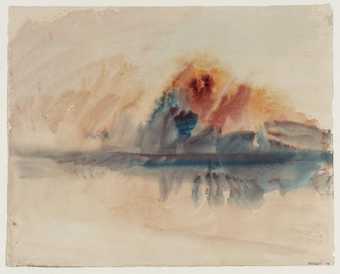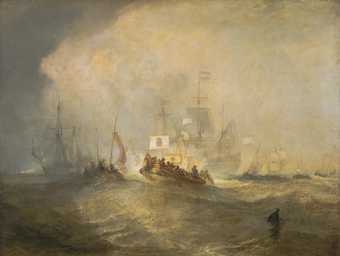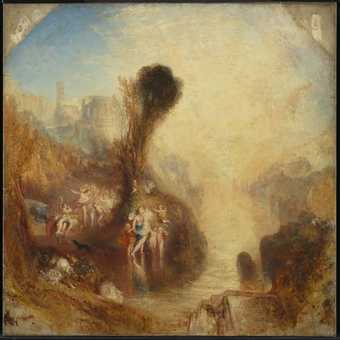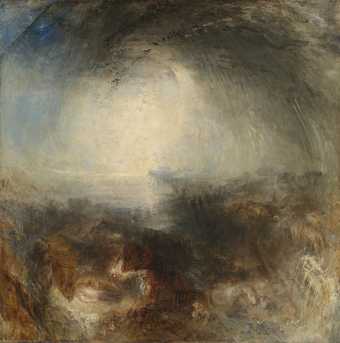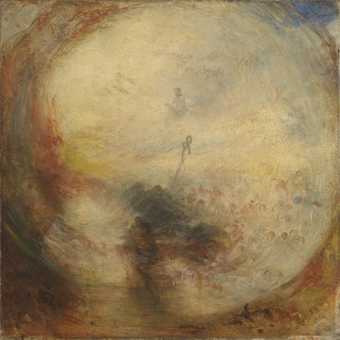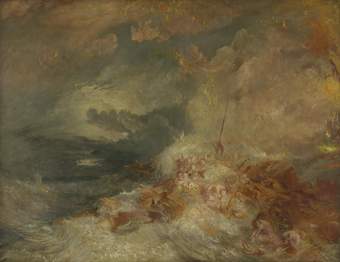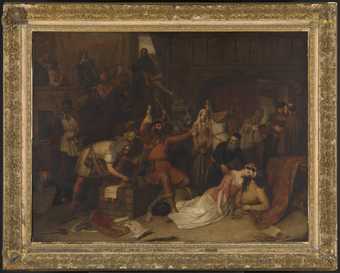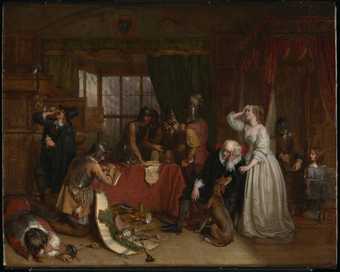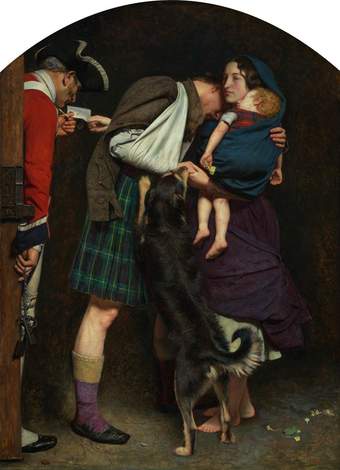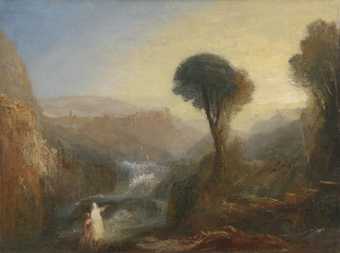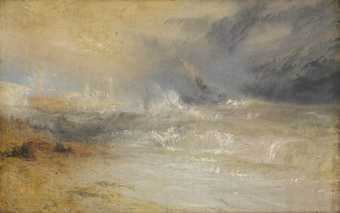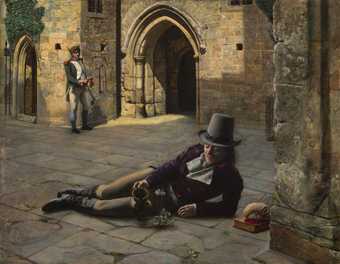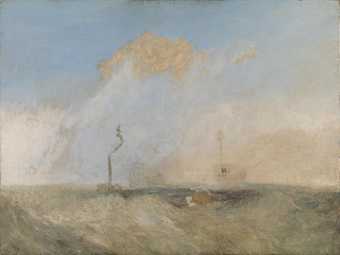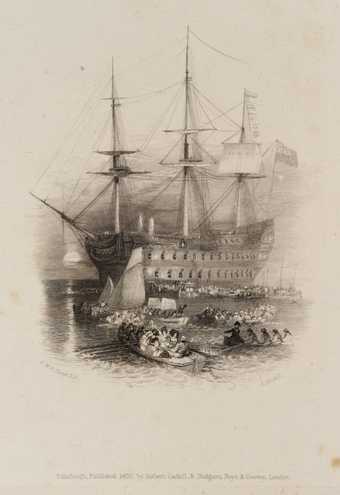
In Tate Britain
- Artist
- Joseph Mallord William Turner 1775–1851
- Medium
- Oil paint on canvas
- Dimensions
- Support: 794 × 794 × 25 mm
frame: 1030 × 1025 × 112 mm - Collection
- Tate
- Acquisition
- Accepted by the nation as part of the Turner Bequest 1856
- Reference
- N00529
Display caption
A pair to Peace, War shows Napoleon in exile on St. Helena, watched over by a British sentry. Perhaps painted as a response to the pomp of Napoleon’s state funeral held in December 1840, Turner shows him instead meditating on his fall from power. Even a mollusc has more self-determination than the former emperor.
The lurid sky and a sluice gate in the shape of a butcher’s cleaver bring carnage and bloodshed to mind, the deaths of thousands being the price of Napoleon’s ambition.
Gallery label, November 2022
Does this text contain inaccurate information or language that you feel we should improve or change? We would like to hear from you.
Catalogue entry
400. [N00529] War. The Exile and the Rock Limpet Exh. 1842
THE TATE GALLERY, LONDON (529)
Canvas, 31 1/4 × 31 1/4 (79·5 × 79·5)
Coll. Turner Bequest 1856 (43, ‘The Sea Lympit’ 2'7" × 2'7"); transferred to the Tate Gallery 1905.
Exh. R.A. 1842 (353); Paris 1983–4 (71, repr. in colour).
Lit. Ruskin 1843, 1860 and 1857 (1903–12, iii, pp. 273, 286, 297, 364, 474; vii, pp. 157–8, 435 n., 438 n.; xiii, pp. 160–61); Thornbury 1862, i, pp. 346–7; ii, p. 196; 1877, pp. 127, 171, 399, 465–6; Hamerton 1879, pp. 292–3; Bell 1901, p. 145 no. 235; Armstrong 1902, pp. 153–4, 225; Davies 1946, p. 186; Clark 1949, p. 106; Finberg 1961, pp. 390, 507 no. 549; Rothenstein and Butlin 1964, pp. 68–70; Lindsay 1966, pp. 190, 202–3; 19662, p. 52; Brill 1969, pp. 24–30, repr. p. 24; Gage 1969, pp. 194, 260 n. 83; Reynolds 1969, p. 187, pl. 164; Stuckey 1976, p. 175; Topliss 1978, pp. 90–1, pl. 5; Wallace 1979, pp. 112–13, pl. 11; Wilton 1979, pp. 200–4, 210–12, 216, pl. 229; Wilton 1980, pp. 76–7, 143, pl. xv; Paulson 1982, pp. 65–6.
Exhibited in 1842 with the lines:
‘Ah! thy tent-formed shell is like
A soldier's nightly bivouac, alone
Amidst a sea of blood
but you can join your comrades.’
—Fallacies of Hope.
Ruskin, who seems to have valued this picture more highly than its companion Peace—Burial at Sea (No. 399), commented ‘The lines which Turner gave with this picture are very important, being the only verbal expression of that association in his mind of sunset colour with blood...the conceit of Napoleon's seeing a resemblance in the limpet's shell to a tent was thought trivial by most people at the time; it may be so (though not to my mind); the second thought, that even this poor wave-washed disk had power and liberty, denied to him, will hardly, I think, be mocked at.’ In Modern Painters Ruskin had expressed his particular liking for ‘the glowing scarlet and gold of Napoleon and Slave Ship [No. 385]’.
The press was universal in its condemnation of this picture, even Blackwood's Edinburgh Magazine for July 1842, which found a general improvement in Turner's exhibits as compared with previous years, dismissing War as ‘a greater absurdity than ever’. The figure of Napoleon was particularly criticised. ‘He is in black military boots’, wrote the critic in the Literary Gazette, 14 May, ‘the continuous reflection of which from his toes in the water give him the appearance of being erected upon two long black stilts, and the whole thing is ... truly ludicrous.’ In a ‘Supplement’ to The Times for 6 May the picture was dismissed as ‘an elongated Napoleon ... running to seed in a redhot atmosphere of brimstone and brickdust.’ The Athenaeum, 14 May, described Turner's War as ‘yet odder than his “Peace” In the midst of a canvas smeared with every shade of rose colour, crimson, vermillion, and orange, is set up a thing—man it assuredly is not—’, an ‘effigy of Napoleon rolled out to a colossal height ... Below the feet of the modern Prometheus lies something about the size of his cocked-hat, called in the Catalogue “a rock limpet”.’ For further criticism see under No. 399 [N00528].
Gage (exh. cat., Paris 1983–4) sees this picture as in part a commentary on B.R. Haydon's Napoleon Meditating at St. Helena, 1829, one of the many versions of which belonged to Samuel Rogers.
Published in:
Martin Butlin and Evelyn Joll, The Paintings of J.M.W. Turner, revised ed., New Haven and London 1984
Explore
- architecture(30,960)
-
- townscapes / man-made features(21,603)
-
- townscape, distant(8,109)
- emotions and human qualities(5,345)
-
- contemplation(141)
- military(301)
- Napoleon(21)
- crime and punishment(436)
-
- prisoner(62)
- war(358)
- birth to death(109)
You might like
-
Joseph Mallord William Turner Sea and Sky
c.1840–5 -
Joseph Mallord William Turner The Prince of Orange, William III, Embarked from Holland, and Landed at Torbay, November 4th, 1688, after a Stormy Passage
exhibited 1832 -
Joseph Mallord William Turner Bacchus and Ariadne
exhibited 1840 -
Joseph Mallord William Turner Peace - Burial at Sea
exhibited 1842 -
Joseph Mallord William Turner Shade and Darkness - the Evening of the Deluge
exhibited 1843 -
Joseph Mallord William Turner Light and Colour (Goethe’s Theory) - the Morning after the Deluge - Moses Writing the Book of Genesis
exhibited 1843 -
Joseph Mallord William Turner A Disaster at Sea
?c.1835 -
Charles Landseer The Pillaging of a Jew’s House in the Reign of Richard I
exhibited 1839 -
Charles Landseer The Plundering of Basing House
exhibited 1836 -
Sir John Everett Millais, Bt The Order of Release 1746
1852–3 -
Joseph Mallord William Turner Tivoli: Tobias and the Angel
c.1835 -
Joseph Mallord William Turner Waves Breaking on a Lee Shore at Margate (Study for ‘Rockets and Blue Lights’)
c.1840 -
Robert Braithwaite Martineau Picciola
1853 -
Joseph Mallord William Turner Steamer and Lightship; a study for ‘The Fighting Temeraire’
c.1838–9 -
After Joseph Mallord William Turner, engraver Edward Goodall The Bellerophon, Plymouth Sound
1834–6

